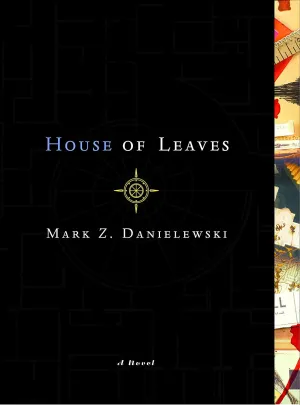House of Leaves is polarizing not because of its plot, but because of its deliberately difficult structure. But that structure affords it an ability to engage its readers in ways that traditional novels cannot.
The Layered Story in House of Leaves
Despite its complexity, the central premise of House of Leaves is deceptively simple.
The novel tells the story of a family that moves into a new house, only to discover it is larger on the inside than it appears from the outside.
This mystery is presented through multiple layers of narrative, each offering a different perspective on the unfolding events:
- The core of the story is a documentary film titled “The Navidson Record,” which chronicles the family’s experiences within the house.
- This film forms the basis of an unfinished manuscript by a blind man named Zampano.
- Following Zampano’s death, his manuscript is discovered by a character named Johnny Truant, who takes it upon himself to complete Zampano’s work.
- Subsequent to Johnny’s death, the manuscript is edited and published by an unnamed editor.
- And then there’s you. The reader.
The novel we read is ostensibly the editor’s finished assembly of Johnny’s efforts, complete with copious footnotes and editorial comments.
House of Leaves’ Narrative Form as a Metaphor for Itself
Paralleling this multi-layered narrative is the physical structure of the book itself.
The novel is filled with unconventional page layouts, colored text, and mirrored writing, all of which serve to enhance the story’s themes and mood.
Page layouts are nontraditional and unpredictable—some pages might be densely packed with text, while others feature only a few scattered words.
The text itself is often presented in a variety of fonts, sizes, and colors, creating a sense of visual dissonance that mirrors the characters’ own disorientation within the house.
These features don’t merely add visual interest; they influence how we interpret the narrative, making the act of reading House of Leaves an immersive, almost tactile experience.
The Role of Typesetting in House of Leaves
One of the most striking elements of House of Leaves is this creative use of typesetting.
Different fonts are used to distinguish between the various narrative voices.
For example, Zampano’s narrative is presented in the Times font, which is often associated with traditional, academic texts. This choice is fitting as Zampano’s manuscript takes the form of a scholarly analysis of “The Navidson Record.”
Johnny Truant’s commentary, represented in Courier font, has a more personal and informal tone, evoking the feel of a typewritten document.
Johnny is an unreliable narrator who interprets Zampano’s work subjectively.
The Editor’s comments are presented in the Bookman typeface, a bold yet conventional font that suggests an authoritative voice.
Meanwhile, the letters written by Johnny’s mother,1 Pelafina, are rendered in the elegant Dante font, reflecting her classical education and the romantic tone of her letters.And Dante Allegheri’s Divine Comedy, which is a major influence on the novel.
Different fonts guide the reader through the novel’s complex structure and distinguish between the multiple narratives.
The Significance of the Blue Font
One of the most iconic elements of House of Leaves is the use of blue font to highlight the word “house” throughout the text.
Rumors suggest that Danielewski chose blue as a reference to the “blue screen” technique in filmmaking (though to my knowledge he hasn’t confirmed this explicitly).Evidence in support of this interpretation can be found in the novel’s opening pages, which feature a quote from the film The Wizard of Oz.
Oh, and by the fact that the shade of blue used in the full-color edition of the novel, Pantone 2728 C / HEX #0047bb, is the same as the color of the blue screen used in filmmaking.
And so if we buy into that line of thought, then the novel presents the blue “house” as a kind of psychological “blue screen.”
Those who enter the house are confronted with an empty, ever-changing structure that reflects their own mental and emotional states.
This use of colored text not only adds a visual element to the narrative but also serves as a symbolic device that enriches the story’s themes.
The Power of Mirrored Text and Footnotes
In addition to its innovative use of typesetting and color, House of Leaves also employs mirrored text and extensive footnotes to disrupt conventional reading patterns.
At various points in the novel, the text is presented backwards or upside-down, requiring the reader to physically rotate the book to continue reading.
This serves to disorient the reader, mirroring the characters’ own disorientation within the ever-shifting confines of the house.
The footnotes, which often contain lengthy asides and digressions, further complicate the narrative by presenting alternate points of view and interpretations.
This helps to create a sense of uncertainty and ambiguity, much like the house itself.
These footnotes serve as a kind of reflection on the text itself, providing an opportunity for the reader to question their own understanding of the narrative.
They can be seen as an invitation to engage with and explore the complexities of House of Leaves on a deeper level.
The novel’s extensive use of footnotes further complicates the reading experience.
Many of these footnotes contain significant narrative content, effectively creating a story within a story.
The footnotes even contain footnotes of their own, leading the reader down a rabbit hole of nested narratives.
This creates an interactive element, as the reader must decide how to navigate these additional layers of text.
The footnotes, therefore, are not mere asides; they are integral to the narrative structure of the novel, adding depth and complexity to the overall reading experience.
Conclusion: A House of Leaves Experience
Reading House of Leaves is not just about consuming a story — it’s about embarking on a journey. The novel’s unique use of typesetting, color, and formatting techniques draws the reader into its labyrinthine world, transforming the act of reading into an active, immersive experience.
Whether it’s the shifting fonts that guide us through the multiple narrative threads, the symbolic use of the blue “house,” or the mirrored text and footnotes that disrupt our conventional reading patterns, every aspect of the novel’s design serves to enhance the story’s themes and mood.
House of Leaves, therefore, is more than just a novel — it’s a testament to the power of ergodic literature, demonstrating how unconventional formatting techniques can be used as a tool for storytelling. It’s a house of leaves in the truest sense, offering a myriad of pathways through its pages, each one leading to new discoveries and interpretations. And like any house, it’s a place to which we can return again and again, always finding something new within its familiar walls.
-
These “complete” collection of these letters are collected in a companion volume: The Whalestoe Letters. ↩

